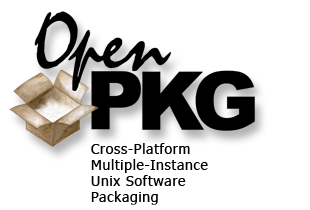Showcase: Demonstration Video
The official OpenPKG Demonstration Video is featuring OpenPKG 2.5 on
FreeBSD 6, Debian GNU/Linux 3.1 and OpenSolaris 10 b34 in parallel
for illustrating OpenPKG's cross-platform and multiple-instance
capabilities.
The video was produced end of April 2006 by the
OpenPKG GmbH and first
spread to the public on DVD in May 2006 by the
OpenPKG Foundation e.V. on the
LinuxTag 2006 exhibition in Wiesbaden, DE.

Download
The video is available in two formats:
- Original video with lossless encoding
for computer screen display at a resolution of 1600x1200 px or lower.
| file: | openpkg-demo-1600x1200-tscc.avi |
| size: | 457 MB (479055798 bytes) |
| checksums: | MD5: 67d13efe51991feabc89dec1ab5c6348 |
| | SHA1: 249b2a94ec42397d50fed717233da6bed32d838a |
| container: | OpenDML AVI 2.0 |
| video: | 1600x1200 TSCC 25fps |
| audio: | PCM 48kHz |
| length: | 34 min |
- Alternative video with lossless encoding and size reduction
for video beamer display at a resolution of 1024x768 px.
| file: | openpkg-demo-1024x768-tscc.avi |
| size: | 538 MB (564116174 bytes) |
| checksums: | MD5: 72e0b4aac88f347319c875f1b340a0ca |
| | SHA1: 7d9125c197a31a8d2c7a72f6fab9bf4f5d2daafe |
| container: | OpenDML AVI 2.0 |
| video: | 1024x768 TSCC 25fps |
| audio: | PCM 48kHz |
| length: | 34 min |
Watching
The video can be directly watched with MPlayer under Unix/X11 (as it
already contains the freely available TSCC codec out-of-the-box).
For watching the video under Windows one can use
an arbitary media player after the freely available
TSCC codec was
downloaded and
installed (requires just about 2 minutes and is totally unintrusive).
Production
For producing the video four VMWare virtual machines were used: three
running under FreeBSD, Debian GNU/Linux and OpenSolaris for the
demonstration run-time backends (the content of the terminal
windows in the video) and one running under Ubuntu GNU/Linux for the
demonstration control frontend (the colorful terminal desktop
in the video).
The control frontend, the heart of the demo, was driven by a tricky
xterm(1) and screen(1) based display setup, input feeded by a custom
scripting engine in the background. The presentation parts of the demo
were generated with OpenOffice Impress. All graphics art was produced
with Adobe Photoshop.
The video parts were captured with VMWare and Camtasia Studio,
frame cutted in VirtualDub, audio annotated in Camtasia Studio again and
rendered into the final videos with VirtualDub.
The production of the video required about 8 man-weeks.




